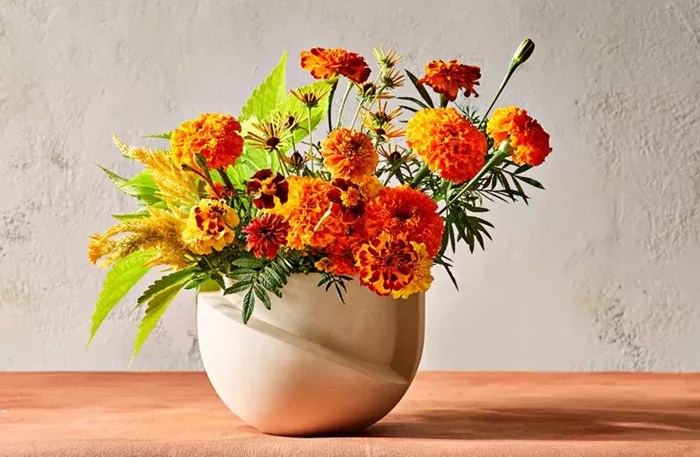While mums are a traditional choice for fall container gardens, they can be challenging to care for, and many common florist mums aren’t frost-resistant. Fortunately, there are several alternatives that provide autumn charm, are easier to grow, and are more resilient to cold weather. Here are some excellent substitutes for mums, along with tips for creating a fall planter full of color and character.
1. Black-Eyed Susan
Rudbeckia ‘Goldstrum’
Black-eyed Susans, also known as Rudbeckia, are available in a variety of colors, but the classic golden-yellow variety is ideal for fall. These hardy plants are easy to grow from seed, quick to establish, and tolerate cold temperatures well. They are also excellent as cut flowers and attract wild birds with their seeds.
2. Calendula
Pot Marigold
Calendulas, or pot marigolds, are known for their bright yellow or orange flowers and their hardy nature. Similar to Rudbeckia, calendulas sprout quickly from seed and can flower from late spring until the first hard frost. They are also suitable for use in cut flower arrangements.
3. Ornamental Grasses
Purple Fountain Grass or Blue Fescue
Ornamental grasses add height and movement to fall containers and come in various striking colors. Purple fountain grass and blue fescue are great choices for autumn planters. For a darker, Halloween-inspired look, black mondo grass offers an interesting alternative.
4. Pansies
Cold-Hardy Blooms
Pansies may appear delicate, but they are surprisingly resilient to cold weather. They thrive when temperatures drop to around 40°F and come in a wide range of colors to complement any fall decor. Their compact size makes them perfect for hanging baskets or as fillers between larger plants.
5. Marigolds
French Marigolds
Marigolds, with their vibrant yellow, orange, and red blooms, are well-suited for fall planters. French marigolds are a popular choice, typically growing 6 to 12 inches tall, but some varieties can reach over 3 feet. Make sure to select the type that fits your container size.
6. Zinnias
Colorful Varieties
Zinnias are easy to grow from seed and offer a wide range of colors, making them a versatile addition to fall containers. While traditional fall colors include warm yellows, oranges, and reds, zinnias can introduce purples, pinks, and other unique shades to your display.
7. Coneflowers
Echinacea ‘Cheyenne Spirit’
Coneflowers are native to North America and are known for their low water needs compared to mums. They come in various colors and sizes and can be used as fillers or focal points in fall planters. Purple coneflowers pair beautifully with yellow or orange blooms and attract seed-eating birds if left uncut.
8. Sedum
‘Autumn Joy’ Sedum
Sedums, like other succulents, store moisture in their leaves and require minimal additional watering. They add texture and color to fall planters, and some varieties, such as ‘Autumn Joy,’ retain their dried flowerheads through winter. Experiment with ground-covering sedums like ‘Dragon’s Blood’ or ‘Angelina’ for a colorful display.
9. Ornamental Peppers
Edible and Decorative
Ornamental peppers add vibrant color to fall containers and produce edible peppers that can enhance autumn recipes. While not as cold-tolerant, covering them with a light sheet or frost blanket can extend their growing season. Varieties like ‘Sedona Sun’ and ‘Black Pearl’ are well-suited for container gardening.
10. Cosmos
’Cosmic Orange’ Cosmos
Cosmos may not be the first choice for fall, but they are easy to grow from seed and adapt well to containers. They can continue blooming until the first frost and are available in colors such as yellow and red. Cosmos are also excellent for autumn bouquets and can be encouraged to bloom more by frequent harvesting.
11. Helenium
Sneezeweed
Helenium, also known as sneezeweed, produces a profusion of orange, yellow, and red flowers from summer to fall. Pairing helenium with ornamental grasses and coneflowers or mixing with sedums and ornamental peppers can create a unique and colorful fall planter.
12. Ornamental Brassicas
Colorful Leaves
Ornamental brassicas, such as cabbage, kale, and Swiss chard, are usually grown in vegetable gardens but can also add color to window boxes and porch planters. Although they are less tasty than edible brassicas, their vibrant leaves in shades of purple, green, and white make them a striking addition to fall arrangements.
13. Amaranth
Bold Colors
Amaranths are known for their colorful seed heads and foliage, adding bold hues to fall containers. While some varieties are too tall for pots, dwarf amaranths like ‘Globe Amaranth’ and ‘Pygmy’s Torch’ are perfect for smaller containers. Amaranths also attract seed-eating birds and add movement to your planter.
14. Asters
Long-Blooming Flowers
Asters come in various colors and sizes and can bloom from summer into fall, sometimes continuing into October. Many North American species are ideal for native planting, and asters are excellent as cut flowers. They also attract pollinators late in the season when other food sources are scarce.
15. Millet
Colorful and Easy to Grow
Millet plants offer a strong silhouette and come in various colors, making them a great addition to fall containers. They are easy to grow from seed and blend well with other autumn plants. Purple millet, with its dark leaves and seed heads, pairs beautifully with bright orange, yellow, or deep red blooms.
These alternatives to traditional mums can provide a vibrant and resilient display for your fall containers, ensuring your garden remains colorful and attractive throughout the season.


